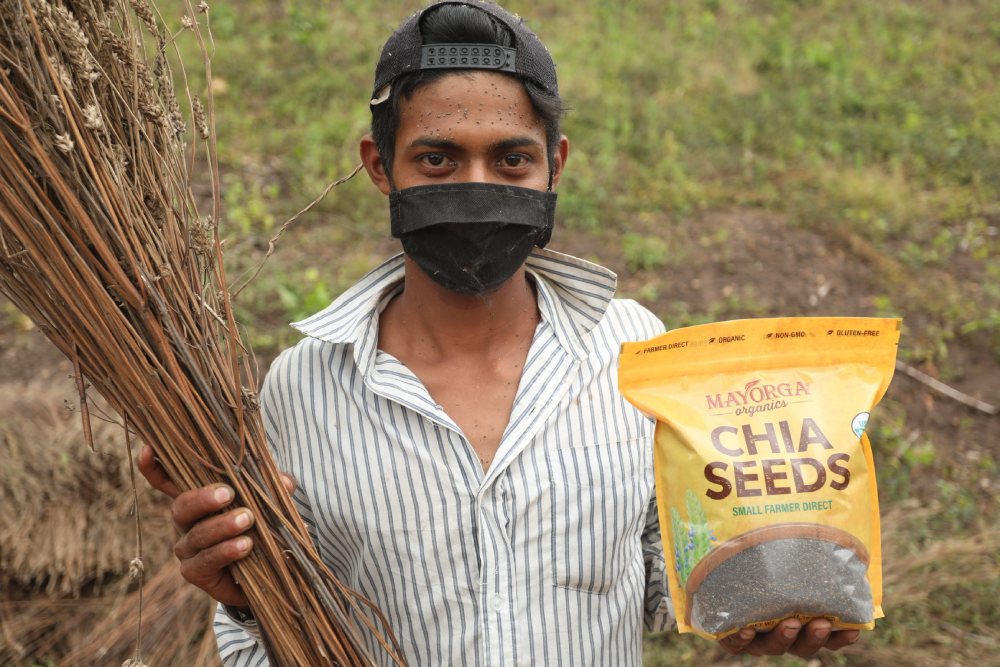Why more coffee producers are choosing to diversify their crops

For centuries, many producers have been growing coffee with other cash crops for a number of reasons. But in recent years, with climate change, an increasingly volatile market, and growing international competition, coffee farmers have had to explore other ways to diversify.
Many producers aren’t able to take on much risk, largely because they are already operating at levels that barely allow them to make ends meet. But one of several ways to adapt successfully is crop diversification – a farming practice whereby producers grow different crops that don’t compete for similar nutrients and resources as coffee plants.
Crop diversification uses techniques such as intercropping, cover cropping, and crop rotation to not only better support local ecosystems, but to also improve farmers’ socioeconomic livelihoods.
So why and how are more coffee producers diversifying their crops? I spoke to Martin Mayorga, founder and CEO of Mayorga Coffee, and Juan Ramón Cruz García, the Nicaragua country manager for Mayorga Coffee, to find out more.
You may also like our article on why relationships are about more than just paying a good price for specialty coffee.
Why crop diversification is integral to sustainable agriculture
Juan Ramón Cruz García is the Nicaragua country manager for Mayorga Coffee – a coffee roaster with a focus on supporting sustainable organic farming practices and uplifting smallholder producers in Latin America. He explains to me what crop diversification is.
“The practice involves rotating different crops across seasons or years to avoid the pitfalls of monoculture farming,” he says. For context, monoculture farming is the practice of growing one type of crop on a piece of land at any given time. While it does have some benefits, there are certainly drawbacks to these methods – including soil degradation.
“Given that coffee isn’t a crop that is rotated, Mayorga’s producers seek other methods to diversify,” Juan adds.
Common practices
As more and more consumers demand sustainably-grown coffee, producers are leveraging their knowledge to implement effective farming practices that incorporate crop diversification.
Intercropping is one of them. According to the Sustainable Agriculture Research and Education programme, intercropping “is an all-encompassing term for the practice of growing two or more crops in close proximity – in the same row or bed, or in rows or strips that are close enough for biological interaction”.
There are a number of benefits to intercropping, such as maximising farm productivity and encouraging more efficient use of resources – like water, light, and nutrients. Over time, compared to monoculture farming systems, intercropping can also increase yields and improve plant resiliency to pests and diseases, as well as leading to increased biodiversity (which has its own advantages).
Soil health is essential to producing quality coffee, and crop diversification through intercropping can conserve and improve soil health. Moreover, this sustainable farming technique can reduce soil erosion and increase organic matter, nitrogen fixation, and the availability of phosphorus.
In addition to intercropping, other techniques include planting cover and buffer crops, which provide shade cover and protection from wind, frost, and heat.
What does crop diversification achieve?
Arguably the most obvious reason to implement crop diversification practices is to improve on-farm sustainability and to increase coffee producers’ resilience to climate change – an issue which has become increasingly hard to ignore.
Martin Mayorga is the founder and CEO of Mayorga Coffee. “Climate change and higher internal costs are affecting a lot of producers’ output,” he tells me. “Being prepared for the impact is an important reality, unfortunately.”
A growing body of research certainly supports this. In a 2022 National Geographic article, a study found that out of coffee, avocados, and cashews, coffee production will be hit the hardest by rising global temperatures.
Unpacking the nexus of issues
It’s not only climate change which is forcing coffee producers to diversify their farming practices, however. An increasingly volatile coffee market has seen the C price reach near-record highs recently, although smallholders are yet to receive more money. As a result, many are turning to other cash crops.
Moreover, with levels of rural-to-urban migration in producing countries on the rise – on top of a growing age gap in coffee farming – it’s becoming more difficult to retain skilled workers on coffee farms.
So for many coffee producers, these complex and interrelated issues raise concerns about a sustainable future for their families and livelihoods. Additionally, devastating outbreaks of diseases like la roya show just how vulnerable global coffee production can be.
“For producers, land is an asset and the goal is to maximise the output of that asset,” Martin says. He tells me that following the 2013 roya plague – which wiped out up to 70% of Latin American coffee farmers’ harvests – Mayorga Coffee worked with producers in northern Nicaragua to plant chia seeds as a means to maintain their income.
The company initially helped 12 coffee producers incorporate chia into their farmland, but now manages about 840 chia producers in Nicaragua, and has expanded the project to work with other farmers in Paraguay and Mexico to meet rapidly growing demand.
By diversifying their crops, farmers were able to maximise both agricultural efficiency of their land and their financial return, preventing them from abandoning coffee production altogether.
Crop diversification & financial security
Growing several different types of cash crops means producers can diversify their income streams – which is a useful tool to combat low coffee prices and food insecurity.
Juan explains that coffee production alone doesn’t usually help to maximise land productivity or generate steady income. He says this is because coffee is only harvested once per year, and its profitability is based on a volatile C market – so prices often fluctuate and remain low.
Instead, Juan tells me that planting a variety of crops that are adapted to local ecosystems – such as banana, avocado, and timber trees – can yield more product within shorter harvest seasons.
With the right level of support and resources, crop diversification can help coffee producers to work in harmony with their land, and allow them to become more financially autonomous.
Crop diversification & organic farming go hand-in-hand
In the context of sustainable agriculture, organic farming is often the most discussed topic. But the crucial role that organic practices play in successful crop diversification is typically overlooked.
Martin reinforces that coffee farmers should consider diversifying their farms and obtaining organic certification at the same time, as both systems are based on similar principles.
“I’m always shocked that organic farming is not the norm because in the next ten to 15 years, producers are going to experience issues with coffee production if they’re not supported to transition,” he says. “If you go to any organic farm, the soil is healthy and moist.
“On conventional farms, however, the soil is dry,” Martin adds. “It’s not providing the plants with any nutrition.”
Obtaining organic certifications
To certify as organic, producers must adhere to a strict set of standards and practices, including:
No use of chemical and synthetic fertilisers, pesticides, and herbicides
Implementing practices which maintain soil health and biodiversity
No spill over of chemicals used for non-organic crops
Although they can be costly, organic certifications come with a number of benefits. Not only can coffee producers prove their commitment to environmental stewardship to traders, roasters, and consumers, but quality and yields can also improve. Moreover, their economic return on investment can increase significantly in the long term – a sentiment that Mayorga Coffee works to support.
“It’s surprising to me how many producers want to get paid more and want to have better output, but they don’t focus on improving soil health,” Martin says. “As an industry, we have forgotten that we’ve asked people who grow our food for to spray chemicals on their own land.
“I personally dismiss any roaster that doesn’t exclusively sell organic coffee when they say they care about producers,” Martin tells me. “I just don’t think we can say that we care about producers when we watch them poison their land, themselves, and their communities.”
For this reason, Mayorga Coffee began selling organic coffee in 1999, and has exclusively sourced certified organic coffee since 2012. Martin explains that the roaster works primarily with co-operatives, but also supports individual producers to receive organic certifications – as well as offering access to agronomic assistance and training to successfully diversify their crops.
How can producers start diversifying their crops?
Transitioning to crop diversification is by no means an easy task, so producers certainly need support from other supply chain actors. Juan tells me that Mayorga Coffee’s direct trade model, for instance, provides smallholder producers with technical assistance, seeds, and access to international buyers.
Mayorga currently focuses on two crop diversification programmes – chia seeds and black beans – with plans to diversify into other crops that will provide better income for producers. Intercropping beans with coffee promotes natural pest control and good soil health, as well as increased productivity, which is why Mayorga decided to help farmers plant both together.
“Coffee producers’ yields and their capacity to generate income more than doubled when growing chia,” Martin says. “Chia production for our producers in Nicaragua increased from one container in 2012 to about 50 in 2023. Company-wide, we’ll move about 170 containers of chia in 2024.”
Understanding the market for diversified crops can be challenging for many producers. Martin explains it’s important for buyers to understand when their services add more value to a farming community and when they don’t, and that not every attempt at diversifying markets will always work.
Ultimately, keeping up with emerging – yet stable – market trends is important. Martin tells me Mayorga is continually working alongside producers to test new products, such as turmeric and quinoa.
What should producers know beforehand?
Juan suggests that producers should first prioritise determining which farming practices will work best to maintain soil health. Secondly, he says, they should consider which crops the market is demanding, while also balancing highly-valuable crops with those that grow best with coffee.
Additionally, Juan tells me that cacao, ginger, turmeric, and beans grow well at lower-elevation coffee farms, while chia can grow in full sun areas.
More importantly, however, Martin says buyers shouldn’t encourage producers to plant up-and-coming crops and coffee varieties without substantial backing and support.
“Whatever suggestions we’re making to producers need to be part of a two-way conversation, and an understanding of what it takes and what it’s going to cost,” he adds. “And roasters better be ready to buy and commit.”
By no means a new concept, crop diversification leverages generations of local and native knowledge to promote biodiversity and bolster producers’ economic stability – leading to a wide range of benefits.
But the transition to adopting and implementing these practices should be done thoroughly and carefully, and with the support of traders and roasters who are committed to building mutually-beneficial relationships.
Enjoyed this? Then read our article on how crop diversification can counter low coffee prices.
Photo credits: Mayorga Coffee
Perfect Daily Grind
Please note: Mayorga Coffee is a sponsor of Perfect Daily Grind.
Want to read more articles like this? Sign up for our newsletter!
The post Why more coffee producers are choosing to diversify their crops appeared first on Perfect Daily Grind.





Responses